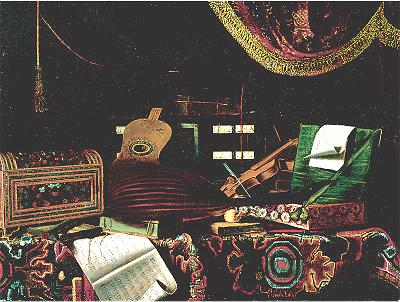Bartolomeo Bettera
Italian, 1639-after 1687, before1700STILL LIFE WITH MUSICAL INSTRUMENTS
SN 658, oil on canvas
From "The Pages".
ARTIST:
Bartolomeo Bettera was born in Bergamo in 1639. Altho’ little is known of his early
life, it is believed he had a son, Bonoventura, in 1663. Bettera was a pupil and then
producer in the workshop of the priest-painter Evaristo Baschenis, who was born in Bergamo
in 1617 and died there in 1677. Bettera was faithful to the examples of his master, who
painted in the tradition of Caravaggio, and art historians continue to recognize these
still-life artists as “Baschenis, Bettera, and Company.” After Baschenis’
death, Bettera moved to Milan, where he continued to work until his own death sometime
after 1687. Bettera’s works are often signed with “BB” divided by a small
cross. |
|
 |
SUBJECT:
We see an arrangement of objects: mandolin, lyre, lute, violin or viola, musical scores,
writing and storage chests. There are decorative elements of rug and pattern, tassel and
scrimshaw. These objects are conventional symbols of cosmic harmony, poetic and musical
inspiration suggesting silence, melancholy, and the vanities of worldly life.
In addition, we must allow that the still-life Natura Morta Italiana is the
artistic subject as well. This form was much practiced in the ancient world, but faded as
an art form – only to reemerge in the Netherlands in the 16th c. Caravaggio’s Basket
of Fruit (1598-1601) is considered by some to be the first “pure”
still-life in the new Italian tradition. Baschenis and Bettera paid homage to that
tradition with their life’s work.
PAINTING:
The somber background shows controlled and contrasting light and color, as well as
directional source of light. There is scrupulous - and surprising - detail, e.g. the
stemmed fruit resting on the book and the vertical tassel, which gives rise to the
speculation that Bettera used a kind of camera lucida, an optical lens-assisted device.
This is one of the first paintings entered in the collection after the original Ringling
bequest. It was a gift in 1951 from A. Everett Austin, first director of the Ringling
Museum. (Mr. Austin, the former director of The Atheneum, Hartford, CT, came to our Museum
in 1946.) In 1976, Tomory listed the painting’s condition as having suffered
scattered surface loss due to flaking, but otherwise in reasonable state. There was
conservation in 1952.
HISTORIC CONTEXT:
Religious conflicts of dogma and theology continued into the 17th c., with struggles for
power among the states and principalities in France, Italy, Spain, and with the Hapsburgs.
Bernini is sculpting; Inigo Jones is completing the Banquet House at Whitehall, Rubens
installs the altarpiece Assumption of the Virgin at Antwerp. Caravaggio dies, and the arts
flourish in Northern Italy.
Additional Bibliography:
Bazin, Germaine. Baroque and Rococo. NY: Thames and Hudson, 1998.
Grun, Bernard. Editor: The Timetables of History, 3rd ed. NY: Simon and Shuster,
1991.
Langdon, Helen. Caravaggio, A Life. NY: Farrar, Strauss, and Giroux, 1999
Roci, Marco and Bettera, Bonoventura. Evaristo Baschenis, Bartolomeo Bonoventura
Bettera. Bergamo:
Poligrafiche Boles, 1985
Salerno, Luigi. La Natura Morta Italiana, 1560-1805. [Still Life Painting in
Italy, 1560-1805.] Roma: Ugo
Bozzi, Ed., 1985.
Weschler, Lawrence. The Looking Glass, Onward and Upward in the Arts. NY:The New
Yorker, 1/31/2000,
pp 64-75.
Museum Label:
Still Life with Musical Instruments
17th century
Artist: Bartolomeo Bettera
Italian, 1639-c.1687, active in Northern Italy
Oil on canvas, 36 5/16 x 47 9/16 in. (92.2 x 120.8 cm)
This was one of the first paintings to enter the collection that was not part of John
Ringling's bequest. It was a gift of A. Everett Austin, Jr., the first director of the
Ringling Museum when it opened to the public in 1946. Since then, important works of art
have been added to the collection by both gift and purchase.
Gift of A. Everett Austin, Jr., 1951, SN658
ringlingdocents.org
|